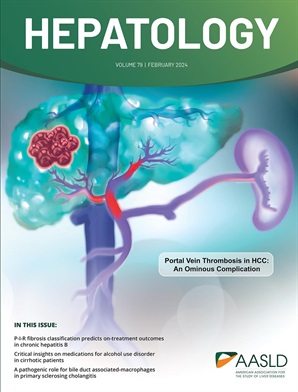应激激活STK24调控的MASTL/YBX1/PAK4轴触发肝细胞癌lenvatinib耐药和肿瘤进展
IF 12.9
1区 医学
Q1 GASTROENTEROLOGY & HEPATOLOGY
引用次数: 0
摘要
背景和目的:许多肝细胞癌(HCC)患者对lenvatinib治疗反应不足。因此,阐明潜在的阻力机制和制定有效的逆转策略是很重要的。方法:我们对lenvatinib耐药细胞系和患者组织进行了全面的转录组和蛋白质组测序分析,以鉴定与lenvatinib耐药相关的关键基因和蛋白质。建立小鼠皮下模型,测定半数最大抑制浓度(IC50),并采用集落形成法研究微管相关丝氨酸/苏氨酸激酶样(MASTL)在肿瘤进展和治疗耐药中的生物学作用。采用分子和生化方法,包括RNA测序、染色质免疫沉淀测序和质谱法,探索MASTL导致肝癌患者对lenvatinib反应不良的潜在机制。结果:在lenvatinib耐药HCC细胞和组织中,MASTL经常上调。MASTL表达增加通过重激活裂丝原活化蛋白激酶(MAPK)信号通路驱动lenvatinib耐药,该信号通路通常被lenvatinib抑制。在机制上,MASTL在S102位点直接磷酸化Y-box binding protein-1 (YBX1),从而促进其对p21活化激酶4 (PAK4)的转录激活。PAK4随后激活MEK1/2,从而促进lenvatinib耐药性。此外,研究结果显示STK24,一种应激调节激酶,可以在lenvatinib暴露下激活MASTL。值得注意的是,破坏MASTL/YBX1/PAK4轴恢复了对lenvatinib的敏感性。结论:我们认为应激诱导的STK24激活的MASTL/YBX1/PAK4轴在lenvatinib耐受中起关键作用。通过靶向MASTL抑制该轴有效克服HCC中lenvatinib的耐药。本文章由计算机程序翻译,如有差异,请以英文原文为准。
The MASTL/YBX1/PAK4 axis regulated by stress-activated STK24 triggers lenvatinib resistance and tumor progression in hepatocellular carcinoma
Background and Aims: Many patients with hepatocellular carcinoma (HCC) present inadequate responses to lenvatinib therapy. Therefore, it is important to elucidate the underlying mechanisms of resistance and to formulate effective reversal strategies. Methods: We conducted comprehensive transcriptome and proteome sequencing analyses of lenvatinib-resistant cell lines and patient tissues to identify critical genes and proteins associated with lenvatinib resistance. Subcutaneous mouse models were established, the half maximal inhibitory concentration (IC50 ) was determined, and colony formation assays were employed to investigate the biological role of microtubule-associated serine/threonine kinase-like (MASTL) in tumor progression and therapeutic resistance. Molecular and biochemical methodologies, including RNA sequencing, chromatin immunoprecipitation sequencing, and mass spectrometry, were employed to explore the underlying mechanisms by which MASTL contributes to poor responses to lenvatinib in HCC. Results: MASTL was frequently upregulated in lenvatinib-resistant HCC cells and tissues. Increased expression of MASTL drove lenvatinib resistance through reactivation of mitogen-activated protein kinase (MAPK) signaling pathways, which is typically inhibited by lenvatinib. Mechanistically, MASTL directly phosphorylated Y-box binding protein-1 (YBX1) at S102, thereby facilitating its transcriptional activation of p21-activated kinase 4 (PAK4). PAK4 subsequently activated MEK1/2, thereby promoting lenvatinib resistance. Additionally, the findings revealed that STK24, a stress-regulated kinase, can activate MASTL under lenvatinib exposure. Notably, disrupting the MASTL/YBX1/PAK4 axis restored sensitivity to lenvatinib. Conclusion: We propose that the MASTL/YBX1/PAK4 axis, which is activated by stress-induced STK24, plays a crucial role in lenvatinib tolerance. Inhibiting this axis by targeting MASTL effectively overcomes lenvatinib resistance in HCC.
求助全文
通过发布文献求助,成功后即可免费获取论文全文。
去求助
来源期刊

Hepatology
医学-胃肠肝病学
CiteScore
27.50
自引率
3.70%
发文量
609
审稿时长
1 months
期刊介绍:
HEPATOLOGY is recognized as the leading publication in the field of liver disease. It features original, peer-reviewed articles covering various aspects of liver structure, function, and disease. The journal's distinguished Editorial Board carefully selects the best articles each month, focusing on topics including immunology, chronic hepatitis, viral hepatitis, cirrhosis, genetic and metabolic liver diseases, liver cancer, and drug metabolism.
 求助内容:
求助内容: 应助结果提醒方式:
应助结果提醒方式:


